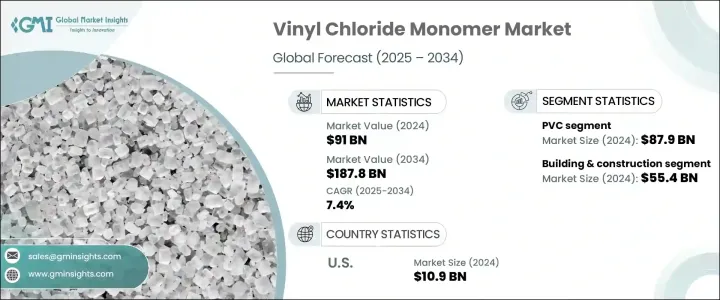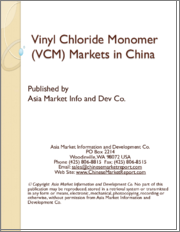
|
시장보고서
상품코드
1716593
염화비닐단량체(VCM) 시장 기회, 성장 촉진요인, 산업 동향 분석 및 예측(2025-2034년)Vinyl Chloride Monomer Market Opportunity, Growth Drivers, Industry Trend Analysis, and Forecast 2025 - 2034 |
||||||
세계의 염화비닐단량체(VCM) 시장은 2024년에 910억 달러를 창출했고 2025년부터 2034년에 걸쳐 CAGR 7.4%를 나타낼 것으로 예측되고 있습니다.
내구성이 높고 범용성이 높은 소재인 폴리염화비닐(PVC)에 대한 수요 증가는 여전히 이 시장 성장의 주요 촉진요인 중 하나입니다. 넓은 산업에서 소비가 급증하고 있습니다. 특히 신흥 경제 국가에서는 급속한 도시화, 산업 개발, 현대적 인프라의 중시가 진행되고 있으며, VCM 기반 제품은 건설, 자동차, 헬스케어, 포장 업계를 지원하는 중요한 역할을 계속하고 있습니다.

건설 붐은 합리적인 가격으로 내구성있는 건축자재에 대한 긴급한 요구에 힘입어 파이프, 창틀, 형재, 바닥재 등의 PVC 소비를 크게 증가 시켰습니다. 산업계가 지속가능성과 환경에 배려한 건축을 중시하는 가운데, 에너지 효율이 높은 건축물에 있어서의 PVC의 역할은 리사이클 가능하고 환경 친화적인 PVC 배합의 기술 혁신과 함께, 세계의 염화비닐단량체(VCM) 시장의 성장 궤도를 한층 더 형성하고 있습니다.
| 시장 범위 | |
|---|---|
| 시작 연도 | 2024년 |
| 예측 연도 | 2025-2034년 |
| 시작 금액 | 910억 달러 |
| 예측 금액 | 1,878억 달러 |
| CAGR | 7.4% |
시장을 제품 유형별로 분석하면 주로 PVC 공중합체, 수지, 염소계 용제로 구분됩니다. 따라서 최대 점유율을 차지하고 시장을 계속 독점하고 있습니다. 파이프, 창문, 바닥재, 의료기기 등 고강도로 유지 보수가 적은 제품의 제조에 적합하기 때문에 VCM 수요는 계속 견고합니다. 재활용 공정이 개선되고 환경 친화적인 PVC 배합으로의 전환이 진행되는 동안 제조업체는 규제 요구 사항과 지속 가능한 제품에 대한 소비자 선호도를 모두 충족 할 수있는 시스템을 갖추고 있습니다.
용도별로는 염화비닐단량체(VCM) 시장은 건설, 헬스케어, 농업, 전기 및 전자, 자동차 산업 등에 걸쳐 있습니다. 뛰어나고 저렴한 비용으로 유지보수가 용이한 재료의 생산에 폴리염화비닐이 사용되고 있으며, 이는 계속해서 시장 성장을 가속하고 있습니다.
미국의 염화비닐단량체(VCM) 시장은 파이프, 창틀, 바닥재 등의 건축 용도에 있어서의 견조한 PVC 수요에 견인되어 2024년에는 109억 달러에 이르렀습니다. - 자동차는 국내외 수요 증가에 대응할 수 있는 체제를 갖추고 있으며, 엄격한 안전·환경 규제가 PVC 기반 솔루션에 대한 신뢰를 높이고 있으며, 지속가능성과 에너지 효율을 중시하는 건축 기준법의 개정이 계속해서 전미 시장 성장을 뒷받침하고 있습니다.
목차
제1장 조사 방법과 조사 범위
제2장 주요 요약
제3장 업계 인사이트
- 생태계 분석
- 밸류체인에 영향을 주는 요인
- 이익률 분석
- 파괴적 혁신
- 향후 전망
- 제조업체
- 유통업체
- 공급자의 상황
- 이익률 분석
- 주요 뉴스와 대처
- 규제 상황
- 영향요인
- 성장 촉진요인
- 건설 및 인프라 리노베이션 프로젝트에 대한 소비 지출 증가
- 헬스케어 분야에서의 PVC 모노머 사용 증가
- 자동차 산업에 있어서의 폴리염화비닐의 소비 확대
- 업계의 잠재적 위험 및 과제
- 염화비닐단량체에 의한 건강에의 악영향
- 성장 촉진요인
- 성장 가능성 분석
- Porter's Five Forces 분석
- PESTEL 분석
제4장 경쟁 구도
- 서론
- 기업 점유율 분석
- 경쟁 포지셔닝 매트릭스
- 전략 전망 매트릭스
제5장 시장 추계·예측 : 용도별(2021-2034년)
- 주요 동향
- PVC
- 공중합체 수지
- 염소계 용제
제6장 시장 추계·예측 : 최종 용도별(2021-2034년)
- 주요 동향
- 건축 및 건설
- 헬스케어
- 농업
- 전기 및 전자
- 자동차
- 기타
제7장 시장 추계·예측 : 지역별(2021-2034년)
- 주요 동향
- 북미
- 미국
- 캐나다
- 유럽
- 독일
- 영국
- 프랑스
- 스페인
- 이탈리아
- 네덜란드
- 아시아태평양
- 중국
- 인도
- 일본
- 호주
- 한국
- 라틴아메리카
- 브라질
- 멕시코
- 아르헨티나
- 중동 및 아프리카
- 사우디아라비아
- 남아프리카
- 아랍에미리트(UAE)
제8장 기업 프로파일
- Agc Chemicals
- Basf
- Bayer
- Dow Dupont
- Formosa Plastics Group
- Ineos Styrolution
- Jubail Chevron Phillips
- LG Chem
- Lyondellbasell Industries
- Nova Chemical
- Occidental Chemical Corporation
- Qatar Vinyl Company Petroquimica Innovay
- Reliance Industries
- Westlake Corporation
The Global Vinyl Chloride Monomer Market generated USD 91 billion in 2024 and is projected to expand at a CAGR of 7.4% between 2025 and 2034. The rising demand for polyvinyl chloride (PVC), a highly durable and versatile material, remains one of the key drivers of this market growth. As a primary raw material for PVC production, vinyl chloride monomer (VCM) is witnessing surging consumption across a wide range of industries. With rapid urbanization, industrial development, and a growing emphasis on modern infrastructure, particularly in emerging economies, VCM-based products continue to play a crucial role in supporting construction, automotive, healthcare, and packaging industries.

The construction boom, fueled by an urgent need for affordable and durable building materials, has significantly increased the consumption of PVC in pipes, window frames, profiles, and flooring. VCM is also benefitting from ongoing technological advancements in production processes that have improved overall efficiency, reduced emissions, and lowered production costs, enabling manufacturers to meet escalating global demand while complying with environmental standards. As industries focus more on sustainability and green construction, PVC's role in energy-efficient buildings, combined with innovations in recyclable and eco-friendly PVC formulations, is further shaping the growth trajectory of the global vinyl chloride monomer market.
| Market Scope | |
|---|---|
| Start Year | 2024 |
| Forecast Year | 2025-2034 |
| Start Value | $91 Billion |
| Forecast Value | $187.8 Billion |
| CAGR | 7.4% |
The market, when analyzed by product type, is primarily segmented into PVC copolymers, resins, and chlorinated solvents. Among these, PVC holds the largest share and continues to dominate the market due to its widespread application in industries modernizing their operations to meet current and future demands. Industries such as construction, healthcare, automotive, and packaging increasingly prefer PVC because of its unmatched chemical resistance, ease of processing, cost efficiency, and longevity. The material's suitability for creating high-strength, low-maintenance products, including pipes, windows, flooring, and medical devices, ensures that the demand for VCM remains strong. With ongoing improvements in recycling processes and a growing shift toward environmentally friendly PVC formulations, manufacturers are better equipped to meet both regulatory requirements and consumer preferences for sustainable products.
By application, the vinyl chloride monomer market spans across construction, healthcare, agriculture, electrical and electronics, and automotive industries. Construction alone accounted for a 60.9% market share in 2024 and is forecasted to grow at a CAGR of 7.5% through 2034. The construction industry's reliance on PVC for producing durable, low-cost, and low-maintenance materials such as pipes, doors, windows, and flooring continues to bolster market growth. The integration of PVC in energy-efficient building solutions, aligned with sustainable construction practices, is fueling further adoption of VCM-based products globally.
The U.S. Vinyl Chloride Monomer Market reached USD 10.9 billion in 2024, driven by robust demand for PVC in construction applications like pipes, window frames, and flooring. With a reliable and cost-effective ethylene supply, largely due to advancements in shale gas extraction, U.S. manufacturers are well-positioned to meet rising domestic and international demand. Additionally, stringent safety and environmental regulations have increased confidence in PVC-based solutions, while updated building codes emphasizing sustainability and energy efficiency continue to drive market growth across the country.
Table of Contents
Chapter 1 Methodology and Scope
- 1.1 Market scope and definition
- 1.2 Base estimates and calculations
- 1.3 Forecast calculation
- 1.4 Data sources
- 1.4.1 Primary
- 1.4.2 Secondary
- 1.4.2.1 Paid sources
- 1.4.2.2 Public sources
- 1.5 Primary research and validation
- 1.5.1 Primary sources
- 1.5.2 Data mining sources
Chapter 2 Executive Summary
- 2.1 Industry synopsis, 2021-2034
Chapter 3 Industry Insights
- 3.1 Industry ecosystem analysis
- 3.1.1 Factor affecting the value chain
- 3.1.2 Profit margin analysis
- 3.1.3 Disruptions
- 3.1.4 Future outlook
- 3.1.5 Manufacturers
- 3.1.6 Distributors
- 3.2 Supplier landscape
- 3.3 Profit margin analysis
- 3.4 Key news and initiatives
- 3.5 Regulatory landscape
- 3.6 Impact forces
- 3.6.1 Growth drivers
- 3.6.1.1 Raising Consumer spending on construction and infrastructural renovation projects
- 3.6.1.2 Increasing use of vinyl chloride monomer in healthcare sector
- 3.6.1.3 Growing consumption of polyvinyl chloride in the automobile industry
- 3.6.2 Industry pitfalls and challenges
- 3.6.2.1 Negative health impact of vinyl chloride monomer
- 3.6.1 Growth drivers
- 3.7 Growth potential analysis
- 3.8 Porter's analysis
- 3.9 PESTEL analysis
Chapter 4 Competitive Landscape, 2024
- 4.1 Introduction
- 4.2 Company market share analysis
- 4.3 Competitive positioning matrix
- 4.4 Strategic outlook matrix
Chapter 5 Market Estimates and Forecast, By Application, 2021 – 2034 (USD Billion) (Kilo Tons)
- 5.1 Key trends
- 5.2 PVC
- 5.3 Copolymer resins
- 5.4 Chlorinated solvents
Chapter 6 Market Estimates and Forecast, By End Use, 2021 – 2034 (USD Billion) (Kilo Tons)
- 6.1 Key trends
- 6.2 Building & construction
- 6.3 Healthcare
- 6.4 Agriculture
- 6.5 Electrical & electronics
- 6.6 Automotive
- 6.7 Others
Chapter 7 Market Estimates and Forecast, By Region, 2021 – 2034 (USD Billion) (Kilo Tons)
- 7.1 Key trends
- 7.2 North America
- 7.2.1 U.S.
- 7.2.2 Canada
- 7.3 Europe
- 7.3.1 Germany
- 7.3.2 UK
- 7.3.3 France
- 7.3.4 Spain
- 7.3.5 Italy
- 7.3.6 Netherlands
- 7.4 Asia Pacific
- 7.4.1 China
- 7.4.2 India
- 7.4.3 Japan
- 7.4.4 Australia
- 7.4.5 South Korea
- 7.5 Latin America
- 7.5.1 Brazil
- 7.5.2 Mexico
- 7.5.3 Argentina
- 7.6 Middle East and Africa
- 7.6.1 Saudi Arabia
- 7.6.2 South Africa
- 7.6.3 UAE
Chapter 8 Company Profiles
- 8.1 Agc Chemicals
- 8.2 Basf
- 8.3 Bayer
- 8.4 Dow Dupont
- 8.5 Formosa Plastics Group
- 8.6 Ineos Styrolution
- 8.7 Jubail Chevron Phillips
- 8.8 LG Chem
- 8.9 Lyondellbasell Industries
- 8.10 Nova Chemical
- 8.11 Occidental Chemical Corporation
- 8.12 Qatar Vinyl Company Petroquimica Innovay
- 8.13 Reliance Industries
- 8.14 Westlake Corporation
















